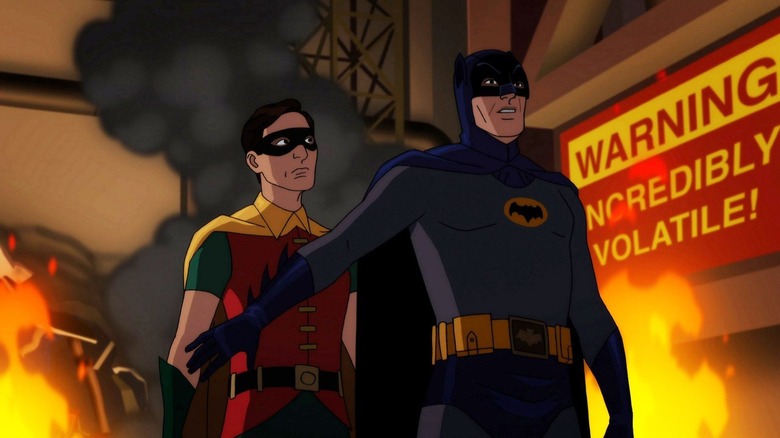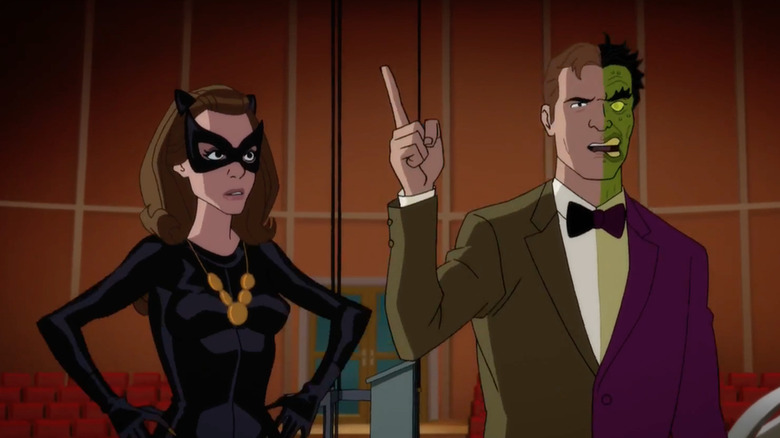Star Trek's William Shatner Played This Classic Batman Villain In A Forgotten Movie
William Dozier's 1966 TV series "Batman" is a brilliant, sublime comedy series, and may easily be one of the best ever made. Its title hero (played by the genius Adam West) and his sidekick Robin (equal genius Burt Ward) delivered their lines in an ultra-earnest fashion that was clearly satire, but that never once winked or hinted to the audience that they were in on the joke. They were square-jawed stalwarts who stood for righteousness in the face of cartoon anarchists who represented counterculture, sexuality, or just good old-fashioned prankstership. The world of Batman was broad and ridiculous, and "Batman" presented a TV series that somehow both vaunted and ridiculed that universe.
The villains on Dozier's show were typically played by well-regarded actors who took the opportunity to cut loose a little, or were hard-working professionals who loved sinking their teeth into goofy-ass comedic roles. The Joker was played by Cesar Romero and the Penguin by Burgess Meredith. Julie Newmar was perfect at Catwoman, although Eartha Kitt was hardly a slouch in the same role. George Sanders, Eli Wallach, and Otto Preminger all had a great time playing Mr. Freeze, and Victor Buono always made me laugh as King Tut. Even Liberace played a villain — and his own twin brother — in a notable episode.
The member of Batman's rogues gallery that was missing from the 1966 TV series, however, was Two-Face: a man bifurcated down the middle, split between evil and good. There were various reasons why Two-Face never showed up in Dozier's show (which we'll get into below), but his absence always seemed like a missed opportunity for Batman fans. Luckily, the problem was finally recified in 2017 with the release of the animated film "Batman vs. Two-Face," a movie animated to look like the 1966 series, and starring its original cast.
William Shatner was hired to play Two-Face.
William Shatner played Two-Face in a 2017 animated film
"Batman vs. Two-Face" was actually a sequel to the 2016 animated film "Batman: Return of the Caped Crusaders." That film reunited Adam West, Burt Ward, and Julie Newmar to reprise their roles from 50 years earlier. It attempted to recapture the aesthetic, tone, and corny writing of Dozier's TV series, and was largely successful. The cast does sound a little older, but the spirit is alive. Also, because it was animated, the film could do things the low-budget 1966 series never could. (The story climaxes with a fistfight on top of a blimp. )
"Return of the Caped Crusaders" was successful enough to warrant the follow-up "Batman vs. Two-Face" the following year. West recorded all his lines, but passed away before the film was released, making "Two-Face" his final project. Because Two-Face had never appeared on the original series, a new animated film was a golden opportunity to finally fill in that particular pop culture gap. Shatner, as mentioned, played Harvey Dent, and the character was designed to look the way Shatner did in the 1960s. The design of the character, with a bright-green half-face and aubergine suit, was also what the character might have looked like using 1966-era makeup technology. "Batman vs. Two-Face" is essentially an elaborate what-if scenario, asking what Dozier's series would have looked like if they ever got around to Harvey Dent.
The plot is 1960s-silly, as it involves Harvey Dent being splashed with liquid evil — a substance that, well, turns him evil. To Shatner's eternal credit, he doesn't camp up his role, but gives a complex and earnest performance, pulling out the duality of Two-Face and the moral decay he seems to be experiencing. He could easily have been a cackling monster, but his acting is closer to "Batman: The Animated Series" than to "Batman Forever."
The film also features a cameo from Harley Quinn, although that character wasn't invented until 1992, so she wouldn't have been on Dozier's series.
The struggles to bring Two-Face to the screen
The story goes that Dozier and the producers of "Batman" were working to find a Two-Face script during the show's (struggling) third season. They liked Two-Face as a character, but his debut kept getting delayed because he might have been a little too strange and scary for a lighthearted series like "Batman." He was, after all, completely scarred down his left side. That didn't really match a series that also had Egghead (Vincent Price) in it.
Harlan Ellison had even turned in a treatment, wherein Harvey Dent was changed from a district attorney into a news anchor. In the treatment, Two-Face was scarred not by chemicals, acid, or liquid evil, but by an exploding spotlight. It was 1968, and Clint Eastwood was being considered for the role, as he had recently starred alongside erstwhile Mr. Freeze Eli Wallach in "The Good, the Bad, and the Ugly." Sadly, the show was canceled before any movement could be made in earnest, and Two-Face would have to remain a missing member of the rogues' gallery in perpetuity. Shatner wouldn't have been able to star as Two-Face in 1968, as he was still busy with "Star Trek."
By 2017, though, Eastwood was too big a star to appear in an animated "Batman" movie. Shatner, however, was very game, and took to the role incredibly well. One can already picture a "Batman" episode, made in 1968 or '69, with William Shatner as Two-Face, so the animated 2017 movie has a certain degree of creative logic to it.
Some fun trivia: a character named Lucilee Diamond appears in "Batman vs. Two-Face," and she's played by Lee Meriwether, who played Catwoman opposite West in the 1966 "Batman" feature film. She appeared alongside, West, Ward, and Newmar. If this was West's final Batman performance, it was a great one to go out on.


